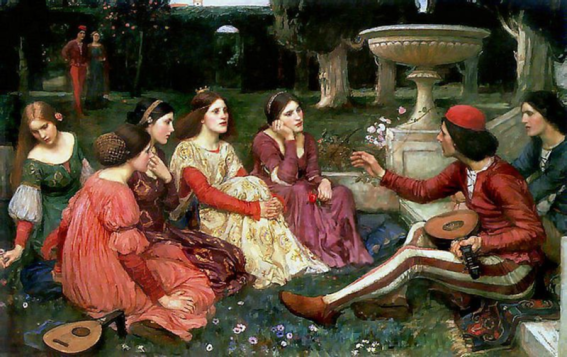In Times of Plague: Petrarca’s Canzonieri, Boccaccio’s Decameron

Scenes from the Decameron, John William Waterhouse, 1916.
As the world faces a grave threat with the Coronavirus, there are predictions of economic doom and demographic catastrophe. The World Bank has declared that 20 million people will be shortly unemployed due to closure of commercial enterprises, big and small. Frontiers of the European Union, once open to all its members, are being closed. The Arab states and superpower America has followed suit.
India has gone the same way, after initially barring the entry of citizens from nations where the virus has appeared. Airlines have stopped flying passengers and airports are deserted. Schools and universities have closed their portals, examinations have been postponed and even big fat Indian weddings have been cancelled. All the gaudy symbols of twenty first century life—malls, restaurants, pubs, shops—are closing down to bar the virus from entering their domain. The scenes across the world are those of silent fear and preparation for Apocalypse.
It is a scene from a science fiction or a prediction from the Doomsday Book. But it is happening and is a near and real danger.
There have been world wars, destruction of cities, factories, schools, hospitals and heritage. People of West and Central Asia – Iraq, Syria, Afghanistan—have been living with horrific destruction for several decades. In the name of democracy, say the perpetrators of this destruction. Citizens of African nations have endured famine and ethnic warfare, brutal depredations of the Boko Haram and calamitous famines. Recently, there was an invasion of locusts which has wiped out annual harvest of grains, posing the threat of famine across North-Central Africa.
There have been epidemics too—the influenza epidemic in 1918 which killed millions, the Sars and Ebola epidemics in the last two decades. But this one—Novel Coronavirus—is affecting nations and people across the globe. Global connectivity, trade and travel have facilitated the lightning- speed spreading across frontiers. Our traffic- snarled streets are still, clamorous cities have fallen into silence, gregarious people are distancing themselves from each other –except cretin-party-goers. For all its modernity, for a historian, the scene evokes echoes of the past.
So take comfort. Humanity has been there before and has risen from pain and pestilence to greater heights. I shall narrate one such episode of indifference to danger and its sublimation into great creativity.
Seven centuries ago, from 1347 to 1351, the Bubonic Plague spread across Europe. The mortality rate is estimated between 75,000,000 to 200,000,000 people. The origin of the malady lies shrouded in mystery and misinformation. Various theories have been offered on the genesis of the plague. Accounts vary of its origin and timing. Excavations and DNA analysis of skeletons in China have revealed deaths through a plague in the second millennium BC. Some anthropologists believe that the plague had its seeds in East Asia 2600 years ago triggered by infected rats. Others said it began in Central Asia which seems unlikely given the arid air, extremes of temperature and sparsely populated towns.
In his History of the Peloponnesian War, the great historian Thucydides recorded how a plague devastated ancient Sparta and Athens in the fourth century BC. A plague came to Constantinople under the reign of Emperor Justinian in the 4th century. Merchant ships from Europe, Asia, North Africa may have brought the contagion. Another view is that this dread disease was carried by merchants, scholars and soldiers on the great Silk Road that connected China to Europe. Strangely, Marco Polo, the intrepid Venetian merchant-explorer and the Russian traveller Afanasy Nikitin who journeyed on this road during this era have not recorded such contagion.
European crusaders came to West Asia and Byzantium from the 11th century; along with their religion they brought various maladies such as syphilis. But the Asian-European encounter enriched Europe’s material and intellectual life. European merchants brought back glass which went into making the great stained glass windows of churches. They also brought silk, cotton, spices and fruits from West Asia.
Philosophical and literary ideas of the made inroads into the bigotry of European minds.
This cross-fertilisation of cultures notwithstanding, some Western historians have declared that the Bubonic plague was transmitted to Europeans during the Crusades. Considering the superior hygienic conditions then prevailing in the East and their advanced medical practices this seems unlikely. Whatever the origin of the “great mortality” the plague made its European appearance in Italy purportedly transmitted through merchants.
The interaction between people through post-Crusade maritime trade, infected grain-ships from North Africa, the filth of Mediterranean harbours, and lack of hygiene expedited spread of the disease. While Western Europe and Britain reeled under the disease it is Italy who took the initiative to protect further spread. The Doge of Venice enacted a law whereby all ships carrying merchandise from infected ports would ‘have to sit at anchor’ away from the harbour for forty days.
Thus came the term quarantine from the Italian word quaranto or forty.
Magnificent Italian cities—Florence, Venice, Naples, Palermo—were ravaged by the Black Death, a name given to the malady which oozed black blood from the victim’s bodies.
Amidst this global catastrophe a new civilisation was stirring in Italy. The trinity of Italian literature comprised of—Dante Alighieri, Francesco Petrarca and Giovanni Boccaccio. While the sombre majesty of Dante’s Divina Comedia was a prelude to the Renaissance, it is Petrarca (1304 -1374) and Boccaccio (1313 -1375) who ushered in the Renaissance that transformed Europe and then the world.
That the intellectual ferment of the Renaissance began in the midst of worldwide disaster of the Black Death is itself a unique phenomenon. Did these two literary titans who saw the plague raging around them find an escape from the surrounding misery by immersing themselves in literary pursuits? Or did the commercial revolution in Italy, initiated by the merchant banking houses of Bardi and Medici create the wealth necessary to finance artists, sculptors and writers? But neither Petrarca nor Boccaccio had princely or financial sponsors. They worked and thought alone. Sometimes the two men met together to discuss their literary ideas.
Before the plague struck Italy, Petrarca and Boccaccio began studying the ancient classics on philosophy and literature. They realised that the Western world had slipped into what they called the “Dark Age,” and resolved to revive its grandeur. They continued the tradition initiated by Dante by discarding Latin and writing in Italian. Their works moved away from the stern medieval Christianity to a new humanism.
Petrarca had spent his youth with his family in the French city of Avignon where his father served the court of the disputed Pope. He received a classical education here. He travelled to Italy, made friends with Florentine littérateurs, settled in Vauclease on the banks of River Sorge from where one could see the soaring church spires of Avignon. There, at a church on Good Friday morning, in April 1327 he saw the exquisite Laura de Noves. She inspired his Canzoniere (Songbook), a novelty in European letters of his time. He wrote about love, human aspirations and dreams and the search for happiness. He celebrated the phenomenal world. Petrarca’s poems stormed the medieval European world and forever changed the mood and temper of its literature.
Petrarca was in Florence, aged forty three, when the Black Death struck. News came that his muse and guiding star, Laura, had perished in the plague. He had a family now but Laura’s loss plunged him to grief. One of his famous letters speaks of his desolation. “The one thousand three hundred and forty eighth year of the sixth age that I am mourning, which has not only stripped us of our friends, but the whole world of its peoples; and if that year passed over anything, then the next one harvests its gleanings and pursues with its death-dealing scythe whatever had survived that storm. When will posterity believe that there was an age without a flood, or a conflagration of heaven and earth, without warfare or other visible disaster, in which neither this region nor that of earth, but the whole globe will be left without an inhabitant? When was any such woe seen or heard reported? In what annals has it been read that homes were empty, cities, abandoned, the countryside neglected, the fields chocked with corpses, and a dreadful and violent desert created all over the world.”
Again, in another letter, he laments: “Where are now our sweet friends, where their beloved faces, their soothing words, their mild and pleasing company? What thunderbolt has devoured these joys, what earthquake overthrown them, what storm submerged them, what abyss opened to swallow them? We were close together; now we are almost alone.”
—Francesco Petrarch, Selected Letters Vol. I (I Tatti Renaissance Library.)
But as often happens, pain is transmuted into creativity. Petrarca began delving into the philosophical heritage of Europe and wrote about its importance. The first stirrings of the Renaissance came with his works.
Boccaccio’s Decameron is a great masterpiece of world literature. He moved away from didactic medieval literature to the concerns of humanity. He set Decameron against the Black Death raging in Florence, indeed Italy. Seven young people flee the city and take rural refuge. Boccaccio unfolds stories across ten days when each of the young people narrate a tale.
The stories vary from humour to gravity, from frivolity to melancholy Boccaccio describes the high-mortality rates and how that became a catalyst for many social and cultural changes in fourteenth-century Europe. The arrogant nobility began to depend on the merchants and plebeians for survival. The plague, like death, was a great leveller. The catastrophe affected the minds and emotions of people. Certitude vanished; enquiries about the nature of existence began.
The tales of the Decameron reflects these changes and also acceptance of reality and the resolve to deal with its gravity.
These two great littérateurs lived and wrote about one of the darkest catastrophes of human history. Out of the devastation they sought certitude not in divinity but in humanity which displayed the most barbaric cruelties and as well as courage and nobility. They saw and lived through the calamity of the Black Death. Their anguish spurred them to richer creativity and enquiry into human existence. Their literary masterpieces were the intellectual foundation of modern Humanism which characterised the Renaissance and which eventually and over the centuries influenced human civilisation.
The author is a retired civil servant and writes on international history. The views are personal.
Get the latest reports & analysis with people's perspective on Protests, movements & deep analytical videos, discussions of the current affairs in your Telegram app. Subscribe to NewsClick's Telegram channel & get Real-Time updates on stories, as they get published on our website.
























